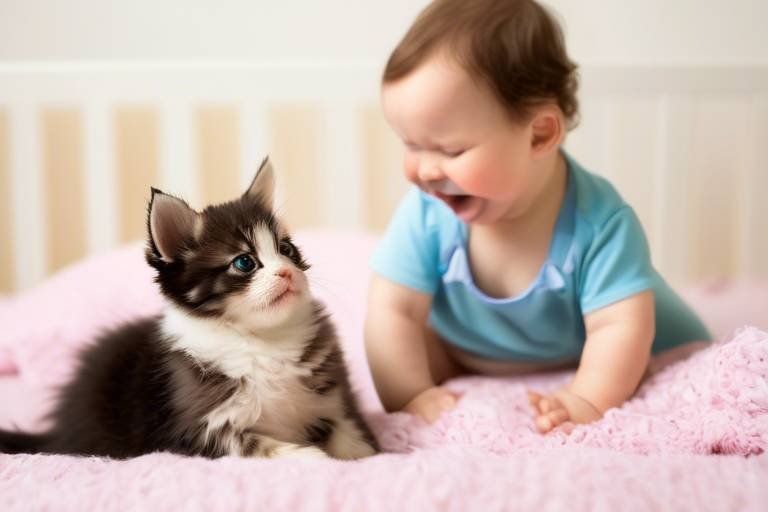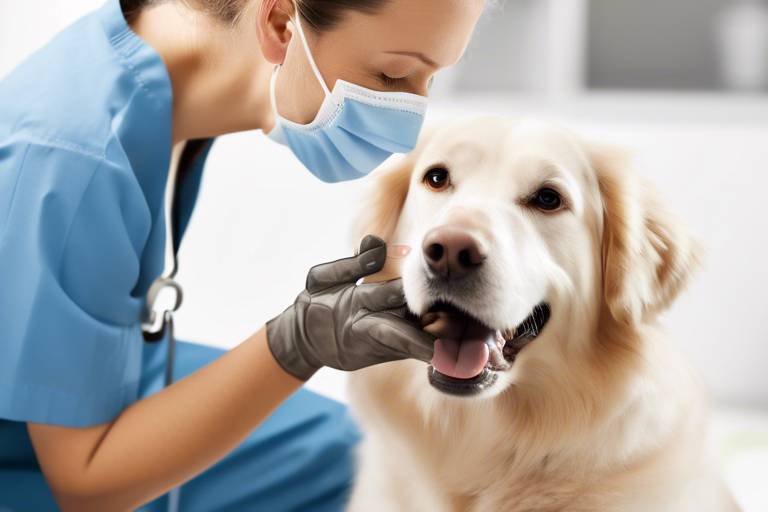Understanding the Risks of Overfeeding Pets
As pet owners, we all want the best for our furry companions. However, it’s easy to fall into the trap of overfeeding, often out of love or the desire to spoil them. But did you know that overfeeding can lead to serious health risks? Just like humans, pets can suffer from obesity, which is not just a cosmetic issue; it’s a gateway to a myriad of health problems. Imagine your beloved dog struggling to climb the stairs or your cat unable to chase after a toy. These scenarios aren't just sad; they're preventable! In this article, we’ll dive deep into the risks associated with overfeeding pets, exploring health implications, behavioral changes, and some proactive measures that you can take to keep your furry friends healthy and happy.
Obesity in pets isn’t just about having a little extra fluff; it can lead to significant health issues that can shorten their lives. Conditions such as diabetes, heart disease, and joint problems are commonly linked to excess weight. For instance, a pet suffering from obesity may develop arthritis due to the extra strain on their joints, making it painful for them to move. This can create a vicious cycle: less movement leads to more weight gain, which leads to even less movement. Understanding these risks is crucial for pet owners who want to provide the best care for their animals. By recognizing that obesity can drastically affect your pet's quality of life, you can take steps to prevent it.
Have you noticed your pet becoming more lethargic or displaying signs of aggression? These could be behavioral changes stemming from overfeeding. When pets are overfed, they often become less active and more prone to mood swings. This decline in energy can lead to a lack of interest in playtime or social interactions with other pets. Imagine a playful puppy turning into a couch potato simply because of too many treats! Recognizing these changes is essential for addressing the root causes and promoting a healthier lifestyle for your pet.
Excess weight can significantly reduce a pet's activity levels, making them less playful and energetic. This decline in physical activity can further exacerbate health problems and reduce overall quality of life. Pets that once loved to run around and play fetch may find themselves panting heavily after just a short walk. This is not just a physical issue; it can also take a toll on their mental well-being. A bored pet is often an unhappy pet, which can lead to destructive behaviors as they seek out stimulation. So, how do we combat this? It all starts with understanding the importance of maintaining a healthy weight.
Overweight pets may struggle with social interactions, as their reduced mobility can limit playtime with other animals. This can lead to isolation and even behavioral issues stemming from boredom or frustration. Imagine a dog that can’t keep up with its friends at the park, watching from the sidelines while others play. This not only affects their physical health but can also impact their emotional well-being. Ensuring that pets can engage in social activities is vital for their happiness and health.
Poor feeding habits can develop in pets that are overfed, such as begging or scavenging for food. These behaviors can be challenging for owners to manage and can contribute to a cycle of unhealthy eating. It’s essential to establish a structured feeding routine to help your pet understand when it’s mealtime and when it’s not. By setting clear boundaries, you can reduce the chances of your pet developing a habit of always looking for food. Remember, it's not just about what you feed them, but how you feed them!
The emotional well-being of pets can be affected by overfeeding, as they may experience stress related to their weight or health issues. A pet that feels uncomfortable in its own skin might become withdrawn or anxious. Ensuring a balanced diet can help promote a healthier mental state. Think of it this way: just as we feel better when we eat right and exercise, our pets benefit from the same lifestyle choices. It's all about creating a supportive environment where they can thrive.
Preventing overfeeding requires a proactive approach from pet owners. Establishing feeding routines and understanding portion sizes are key components in maintaining a healthy weight for pets. It’s crucial to educate yourself about the nutritional needs specific to your pet’s breed and age. Don’t hesitate to consult with your veterinarian for tailored advice on your pet’s diet.
Learning about proper portion sizes for different breeds and sizes of pets is vital. This knowledge helps owners make informed decisions about their pets' diets and avoid overfeeding. For example, a small breed dog requires significantly less food than a large breed, yet many owners make the mistake of feeding them the same amount. Utilizing feeding guidelines provided by pet food manufacturers can be a great starting point. Always remember: a little knowledge goes a long way in ensuring your pet's health!
Incorporating regular exercise into a pet's routine is essential for maintaining a healthy weight. Engaging pets in play and outdoor activities can help counteract the effects of overfeeding. Just like us, pets need a mix of physical and mental stimulation to stay happy and healthy. Think of fun ways to get your pet moving—whether it’s a game of fetch, a brisk walk, or even agility training. The more you engage your pet, the healthier they will be!
- What are the signs that my pet is overweight? Look for signs like difficulty breathing, reluctance to exercise, and a noticeable lack of energy.
- How can I help my pet lose weight? Consult your veterinarian for a tailored diet plan and incorporate regular exercise into their routine.
- Is it okay to give my pet treats? Yes, but moderation is key! Treats should not exceed 10% of their daily caloric intake.

The Health Implications of Obesity
Obesity in pets is not just a cosmetic issue; it’s a serious health concern that can lead to a myriad of complications. Just like in humans, excess weight can significantly increase the risk of developing chronic diseases. For instance, pets that are overweight are at a higher risk of suffering from diabetes, which can lead to a lifetime of insulin shots and a restricted diet. Imagine having to manage your pet’s food intake meticulously every single day—sounds exhausting, right?
Moreover, heart disease is another grave concern. The extra weight puts additional strain on a pet’s heart, making it work harder than it should. This can lead to conditions such as congestive heart failure, which is not only distressing for the pet but also heartbreaking for the owner. Think of it this way: just as a car struggles to run efficiently when overloaded, so does a pet’s body when it carries excess weight.
Joint problems are also prevalent among obese pets. The added weight can lead to conditions like arthritis, which can severely limit a pet’s mobility and quality of life. A once-active dog that loved to chase after balls can transform into a lethargic companion, struggling even to take short walks. It’s a tragic transformation that many pet owners witness, and it’s often preventable.
Here’s a quick overview of some serious health implications associated with pet obesity:
| Health Issue | Description |
|---|---|
| Diabetes | Chronic condition requiring insulin management. |
| Heart Disease | Increased strain on the heart can lead to failure. |
| Joint Problems | Arthritis and mobility issues due to excess weight. |
| Respiratory Issues | Obesity can lead to breathing difficulties. |
Additionally, the emotional toll of obesity should not be overlooked. Pets may experience depression or anxiety due to their inability to engage in activities they once enjoyed, leading to a vicious cycle of inactivity and weight gain. It’s crucial for pet owners to recognize these signs and take action before it’s too late. Remember, a happy pet is an active pet!
In conclusion, understanding the health implications of obesity is vital for every pet owner. By recognizing the risks associated with being overweight, you can take proactive steps to ensure your furry friend lives a long, healthy, and happy life. After all, wouldn’t you want your pet to enjoy the same adventures and activities that they did when they were younger? The journey to a healthier pet starts with awareness and action.
- What are the signs that my pet is overweight? Look for a lack of a defined waist, difficulty in feeling the ribs, and decreased energy levels.
- How can I help my pet lose weight? Gradually reduce their food intake and increase physical activity through play and exercise.
- Should I consult a vet about my pet's weight? Absolutely! A veterinarian can provide tailored advice and help create a weight loss plan.

Behavioral Changes Due to Overfeeding
Overfeeding our beloved pets might seem harmless at first, but it can lead to significant behavioral changes that can affect their overall happiness and health. Imagine your pet, once a lively bundle of joy, now becoming a couch potato. This transformation is often a direct result of excess weight. Pets that are overfed may exhibit a range of behaviors that indicate they are not just physically affected but emotionally impacted as well.
One of the most noticeable changes is lethargy. Overweight pets tend to have lower energy levels, which can prevent them from engaging in play or even going for walks. This decline in activity can lead to a vicious cycle: less exercise leads to weight gain, which in turn leads to even less exercise. It's almost like watching a balloon slowly deflate—each moment of inactivity takes away a bit of their spirit.
But it doesn’t stop there. Overfeeding can also lead to behavioral issues such as aggression or anxiety. Picture this: your pet is constantly hungry, not because they need food, but because they’ve developed a habit of begging or scavenging. This behavior often stems from a lack of proper feeding routines and can create a stressful environment for both the pet and the owner. In some cases, pets may even become aggressive when they feel their food is threatened, leading to a tense atmosphere at home.
Additionally, social interactions can suffer. Overweight pets may struggle to engage with others, both human and animal. Their reduced mobility can limit playtime with other pets, leading to feelings of isolation. Imagine a dog that can’t keep up with its friends during a game of fetch; the frustration can lead to behavioral issues stemming from boredom or loneliness. It’s heart-wrenching to think about how overfeeding can rob our pets of joyful experiences.
Moreover, poor feeding habits can develop as a direct consequence of overfeeding. Pets may start to exhibit behaviors such as constant begging or scavenging for food, which can be frustrating for owners. These habits not only disrupt the household but can also contribute to a cycle of unhealthy eating. It’s like teaching a child that throwing a tantrum gets them a cookie; the behavior becomes reinforced over time, making it harder to break.
Lastly, the emotional well-being of our pets can be significantly affected by their weight. Pets that are overweight may experience stress related to their health issues, and this stress can manifest in various ways, from destructive behaviors to withdrawal. A balanced diet is not just about physical health; it’s also about ensuring our furry friends feel good mentally and emotionally. Just like us, pets thrive when they feel happy and secure in their environment.
- What are the signs that my pet is overweight? Look for signs like difficulty in breathing, reduced activity levels, and an inability to feel their ribs when you gently press on their sides.
- How can I help my pet lose weight? Gradually adjust their diet, increase their physical activity, and consult your veterinarian for a tailored weight-loss plan.
- Can overfeeding affect my pet's mood? Yes, overfeeding can lead to lethargy and anxiety, impacting their overall mood and behavior.
Impact on Activity Levels
When it comes to our beloved pets, **activity levels** are crucial for their overall health and happiness. Unfortunately, overfeeding can create a vicious cycle that leads to decreased mobility and energy. Imagine your pet, once a lively ball of energy, now sluggishly lounging around the house. This transformation doesn’t happen overnight, but rather as a gradual consequence of excessive weight gain. As pets pack on the pounds, their ability to engage in physical activities diminishes, and they may find themselves less inclined to romp around or chase after their favorite toys.
In fact, research shows that pets that are overweight are significantly less active than their leaner counterparts. This decline in activity can lead to a range of issues, including:
- Increased Risk of Health Problems: Just as humans who lead sedentary lifestyles are prone to various health issues, the same applies to pets. Obesity can lead to conditions like diabetes and heart disease, which are exacerbated by inactivity.
- Reduced Playfulness: Overweight pets may not have the energy or stamina to engage in play. This not only affects their physical health but can also lead to boredom and frustration.
- Joint Pain: Carrying excess weight can put undue stress on joints, leading to arthritis and other painful conditions. This can make even simple movements, like walking or jumping, a challenge for your furry friend.
As a pet owner, it’s essential to recognize these signs early on. If your pet seems less enthusiastic about their usual activities or tires out quickly, it might be time to evaluate their diet and exercise routine. Just like humans, pets need a balanced approach to their health, which includes a combination of proper nutrition and regular physical activity.
To counteract the negative effects of overfeeding, consider implementing a structured exercise plan. Activities such as daily walks, interactive play sessions, or even agility training can help to boost your pet's activity levels. Not only will this improve their physical health, but it will also enhance their mood and mental well-being. Remember, a tired pet is often a happy pet!
In conclusion, the impact of overfeeding on a pet's activity levels is profound. By being proactive and ensuring your furry friend maintains a healthy weight, you can help them lead a more active, joyful life. After all, our pets rely on us to keep them healthy and happy, so let’s not let excess weight stand in the way of their well-being.
- What are the signs that my pet is overweight? Look for a noticeable lack of waist, difficulty in feeling their ribs, and lethargy in their daily activities.
- How can I help my pet lose weight? Gradually reduce their food intake and increase their exercise, ensuring you consult a veterinarian for a tailored plan.
- Are certain breeds more prone to obesity? Yes, some breeds, like Bulldogs and Dachshunds, are more likely to gain weight due to their genetic predispositions.
- How much exercise does my pet need? Most pets require at least 30 minutes of activity daily, but this can vary based on age, breed, and health condition.
Social Interactions
When we think about our furry friends, we often picture them running around, playing with their pals, and engaging in joyful antics. However, overweight pets may not experience this vibrant social life. Imagine trying to join a game of fetch when you're out of breath after just a few minutes—frustrating, right? This is the reality for many pets struggling with excess weight. Their reduced mobility can hinder their ability to interact with other animals, which can lead to feelings of isolation and loneliness.
Pets are social creatures, much like us. They thrive on interaction, whether it's with their human companions or fellow animals. However, when a pet is overweight, they may find it challenging to keep up during playtime. This can result in a decline in their social skills, as they may avoid playing altogether, leading to boredom and even behavioral issues. For example, a dog that can't chase after a ball may become frustrated and resort to destructive behaviors at home. It's essential to recognize that their social interactions are not just about fun; they are crucial for their mental and emotional well-being.
Moreover, the effects of overfeeding extend beyond just physical health; they can also impact how pets relate to their environment. Overweight pets may experience anxiety or stress when they are unable to engage in activities they once enjoyed. This not only affects their happiness but can also strain the bond they share with their owners. As responsible pet owners, we must be aware of these changes and take proactive steps to ensure our pets maintain a healthy weight, which in turn supports their social interactions.
To foster better social interactions, consider the following strategies:
- Regular Exercise: Engage in daily activities that encourage movement, like walks or playdates with other pets.
- Socialization Opportunities: Introduce your pet to other animals in controlled environments to help them build confidence.
- Positive Reinforcement: Reward your pet for engaging in social activities, reinforcing their desire to interact.
By focusing on these areas, we can help our pets not only shed those extra pounds but also enhance their overall quality of life. After all, a happy pet is a healthy pet, and a healthy pet is a social pet!
Q: How can I tell if my pet is overweight?
A: You can check if your pet is overweight by feeling their ribs; you should be able to feel them without excess fat covering. Additionally, a noticeable waistline when viewed from above is a good indicator.
Q: What are some healthy treats for my pet?
A: Opt for fruits and vegetables like carrots, apples, or green beans as treats. Always ensure they are safe for your specific type of pet.
Q: How often should I exercise my pet?
A: Aim for at least 30 minutes of exercise daily, but this can vary based on your pet's age, breed, and health condition. Always consult your veterinarian for tailored advice.
Feeding Habits
When it comes to our beloved pets, their can make or break their health. Overfeeding can lead to a range of undesirable behaviors that not only affect their physical well-being but also their psychological state. Imagine your furry friend, once a playful ball of energy, now constantly begging for more food, rummaging through the trash, or even stealing snacks off the table. These behaviors stem from a cycle of overindulgence that can be difficult to break. It's essential to recognize how these habits develop and the impact they have on your pet's life.
Overfeeding often creates a vicious cycle. Pets that are given too much food may start to associate mealtime with excessive excitement, leading them to beg more frequently. This constant pleading for food can become a nuisance for owners, and in an attempt to quiet them, many people unintentionally reinforce this behavior by giving in. It's a bit like giving a child candy to stop them from whining; it may work in the moment, but it sets a precedent that can lead to bigger problems down the line.
Moreover, pets that are overfed may develop poor eating habits that can be hard to change. For instance, they might start scavenging for food whenever they get the chance, leading to an unhealthy relationship with food. Instead of eating when they are hungry, they may eat out of boredom or habit. This behavior can be detrimental, not just for their waistline but also for their overall health. To combat these issues, it’s crucial to establish a consistent feeding routine and to understand the appropriate portion sizes for your pet's specific needs.
To help pet owners navigate the complexities of feeding habits, here are some key points to consider:
- Consistency is Key: Stick to a regular feeding schedule to help your pet understand when to expect their meals.
- Measure Portions: Use a measuring cup to ensure you are feeding the correct amount based on your pet's size and dietary requirements.
- Avoid Table Scraps: Resist the temptation to share your meals with your pet, as this can lead to unhealthy eating patterns.
- Provide Healthy Treats: If you want to give your pet a snack, opt for healthy options like carrot sticks or apple slices instead of high-calorie treats.
By being mindful of these feeding habits, you can help your pet maintain a healthy weight and a positive relationship with food. Remember, a balanced diet and proper portion control are essential in ensuring your furry friend lives a long, happy, and active life.
1. How can I tell if my pet is overweight?
Look for signs such as difficulty in feeling their ribs, a lack of a defined waist, or lethargy. A visit to the vet can provide a more accurate assessment.
2. What is the best way to transition my pet to a healthier diet?
Gradually mix the new food with the old food over a week, slowly increasing the new food's proportion to avoid digestive issues.
3. How much exercise does my pet need?
It varies by breed and age, but generally, dogs require at least 30 minutes to 2 hours of exercise daily, while cats benefit from playtime throughout the day.
4. Can I use food puzzles to help with my pet's eating habits?
Absolutely! Food puzzles can stimulate your pet mentally and slow down their eating, promoting a healthier relationship with food.
Emotional Well-being
When it comes to our furry companions, their is just as important as their physical health. Overfeeding can lead to a myriad of emotional issues that can affect a pet's overall happiness. Imagine how you would feel if you were constantly uncomfortable in your own body; pets experience similar feelings when they are overweight. The stress associated with their excess weight can lead to anxiety, depression, and frustration. This is why it's essential for pet owners to pay close attention to their pet's emotional state, especially in relation to their dietary habits.
Pets often communicate their feelings through behavior. For instance, an overweight dog might show signs of lethargy, preferring to lie around rather than engage in play. This can create a vicious cycle: less playtime leads to more weight gain, which in turn leads to even less activity. It's crucial to recognize these patterns early on. By fostering a healthy diet and encouraging physical activity, you can help your pet break free from this cycle and boost their emotional health.
Moreover, pets that are overfed often develop a complicated relationship with food. They may start to associate food with comfort, leading to behaviors such as begging or scavenging. This can be incredibly challenging for owners to manage. Imagine a child who learns that throwing a tantrum gets them a cookie; similarly, pets can learn to manipulate their owners for treats. To combat this, establishing a routine can help pets understand when to expect meals, reducing anxiety and promoting a sense of security.
In addition, pets can feel isolated when their weight limits their ability to socialize. For example, an overweight cat may avoid play with other cats, leading to loneliness and boredom. This isolation can spiral into behavioral issues, such as aggression or excessive vocalization. By ensuring that your pet maintains a healthy weight, you not only promote their physical health but also enhance their emotional well-being.
To sum it up, the emotional well-being of your pet is intricately linked to their diet and lifestyle. By being mindful of their feeding habits and encouraging an active lifestyle, you can help your furry friend lead a happier, healthier life. Remember, a pet that feels good physically is likely to feel good emotionally, too!
- How can I tell if my pet is overweight?
Look for signs such as difficulty in feeling their ribs, a lack of a defined waist, and reduced energy levels. Regular vet check-ups can also provide insights. - What should I do if my pet is overweight?
Consult your veterinarian for a tailored weight management plan that includes a balanced diet and a regular exercise routine. - Can emotional stress make my pet gain weight?
Yes, stress can lead to overeating in pets. Addressing their emotional needs is crucial for maintaining a healthy weight. - How much exercise does my pet need?
This varies by breed and age, but generally, pets should have at least 30 minutes of activity each day.

Preventive Measures for Pet Owners
As a responsible pet owner, it’s essential to take a proactive stance in preventing overfeeding and ensuring your furry friend maintains a healthy weight. One of the first steps is to establish a consistent feeding routine. Just like humans, pets thrive on routine. Feeding your pet at the same times each day not only helps regulate their appetite but also sets clear boundaries for when they can expect to eat. This consistency can prevent them from begging or scavenging for food outside of meal times.
Understanding portion control is critical. Each pet has different dietary needs based on their breed, size, age, and activity level. For instance, a small Chihuahua will require significantly less food than a large Labrador Retriever. To help you navigate portion sizes, consider consulting your veterinarian or using feeding guidelines provided on pet food packaging. Here’s a quick reference table to illustrate the differences:
| Pet Size | Daily Caloric Needs (Approx.) |
|---|---|
| Small (up to 15 lbs) | 200-300 calories |
| Medium (16-40 lbs) | 400-800 calories |
| Large (41-100 lbs) | 900-2000 calories |
Another vital aspect of preventing overfeeding is incorporating regular physical activity into your pet's daily routine. Just like us, pets need exercise to stay healthy and maintain their weight. Aim for at least 30 minutes of exercise a day, which can include walks, playtime, or even agility training. Not only does this keep their bodies fit, but it also stimulates their minds, reducing boredom and the likelihood of destructive behaviors. Remember, a tired pet is a happy pet!
Additionally, it’s important to monitor your pet's weight regularly. Weighing your pet at home or during veterinary visits can help you catch any weight gain early on. If you notice any significant changes, it’s crucial to adjust their diet and exercise routine accordingly. Keeping an eye on their body condition score (BCS) can also be beneficial. A simple scale from 1 to 9 can help you determine if your pet is underweight, ideal, or overweight.
Lastly, consider providing healthy treats and snacks. Instead of reaching for high-calorie commercial treats, opt for fruits or vegetables that are safe for pets, such as carrot sticks or apple slices (without seeds). These options are not only lower in calories but also offer nutritional benefits. Remember, treats should only make up about 10% of your pet’s daily caloric intake.
By implementing these preventive measures, you can help your pet lead a healthier, happier life. Remember, a little effort goes a long way in ensuring your furry companion stays fit and full of energy!
- How can I tell if my pet is overweight? Look for signs such as difficulty in feeling their ribs, lack of a defined waist, or lethargy. Regular vet check-ups can also help assess their weight.
- What should I do if my pet is overweight? Consult your veterinarian for a tailored weight loss plan that includes a balanced diet and an exercise regimen.
- How often should I feed my pet? Most adult pets do well with two meals a day, but puppies and kittens may require more frequent feedings. Always check with your vet for specific guidelines.
Understanding Portion Control
When it comes to keeping our furry friends healthy, portion control is an essential component that pet owners must grasp. Just like humans, pets can easily fall into the trap of overeating, which can lead to a multitude of health issues. So, how can we ensure that our pets are getting the right amount of food? It all starts with understanding what constitutes a proper portion.
Each pet is unique, and their dietary needs vary based on factors such as age, weight, breed, and activity level. For instance, a young, energetic Labrador will require more calories than a sedentary senior Chihuahua. This is where consulting with a veterinarian becomes invaluable. They can provide tailored advice on the appropriate portion sizes for your specific pet, taking into account their individual needs.
To help visualize the right portions, consider the following table that outlines general guidelines based on weight:
| Pet Weight (lbs) | Daily Caloric Intake (kcal) | Recommended Portion Size (cups) |
|---|---|---|
| 5-10 | 200-300 | 1/2 - 1 |
| 11-20 | 300-400 | 1 - 1 1/2 |
| 21-40 | 400-600 | 1 1/2 - 2 1/2 |
| 41-60 | 600-800 | 2 1/2 - 3 1/2 |
Keep in mind that these are just general guidelines, and specific brands of pet food may have different caloric densities. Always check the feeding instructions on the packaging and adjust as necessary. It's also important to note that treats can add up quickly, so they should be included in the overall caloric intake.
In addition to understanding portion sizes, it's crucial to establish a consistent feeding routine. This means feeding your pet at the same times each day and avoiding free-feeding, where food is left out all day. A structured schedule not only helps manage your pet's weight but also creates a sense of security and routine in their lives.
Furthermore, monitoring your pet's weight regularly can help you catch any changes early. If you notice your pet gaining weight, it may be time to reevaluate their portion sizes and activity levels. Remember, a few extra pounds might not seem like much, but they can significantly impact your pet's health and happiness.
Ultimately, understanding portion control is about being informed and proactive. By taking the time to learn about your pet's specific needs and adjusting their diet accordingly, you can ensure they lead a long, healthy, and happy life.
- How can I tell if my pet is overweight? Look for signs such as difficulty in feeling their ribs, a lack of waistline, and reduced energy levels.
- What should I do if my pet is overweight? Consult your veterinarian for a tailored diet and exercise plan.
- Are there specific foods that help with weight management? Yes, look for high-fiber, low-calorie foods that promote satiety.
- How often should I feed my pet? It’s best to establish a regular feeding schedule, typically 1-2 times a day.
Encouraging Physical Activity
When it comes to keeping our furry friends healthy, is one of the most effective strategies we can adopt. Just like humans, pets thrive on movement, and incorporating regular exercise into their daily routine can significantly improve their overall well-being. Think of exercise as a magic potion that not only helps burn off those extra calories but also boosts their mood and keeps their minds sharp!
So, how can we make sure our pets are getting enough exercise? First and foremost, it’s essential to find activities that they enjoy. Whether it’s a game of fetch in the park, a brisk walk around the neighborhood, or even some playful tug-of-war at home, the key is to keep it fun and engaging. Remember, a bored pet is often an overweight pet, so mixing up the routine can make a world of difference!
Here are a few ideas to help you get started:
- Daily Walks: Aim for at least 30 minutes of walking each day. This not only helps with weight management but also allows your pet to explore new smells and sights.
- Playtime: Dedicate time each day for play. Use toys that encourage movement, like balls or frisbees, to get them running and jumping.
- Doggy Playdates: Socializing with other pets can motivate your dog to be more active. Arrange playdates with friends who have dogs, or visit a local dog park.
- Obstacle Courses: Set up a mini obstacle course in your backyard or living room. Use cushions, chairs, and other safe household items to create challenges that encourage your pet to jump, crawl, and weave.
It's also essential to monitor your pet's activity levels. Just like we track our fitness, keeping an eye on how much your pet moves can help you identify any changes in behavior or energy levels. There are various pet fitness trackers available that can give you insights into your pet's activity patterns, making it easier to adjust their exercise routine as needed.
Lastly, remember that consistency is key. Establishing a routine not only helps your pet know what to expect but also reinforces the habit of regular physical activity. Just like us, pets thrive on routine, and the more they associate exercise with positive experiences, the more likely they are to enjoy it!
Q: How much exercise does my pet need?
A: The amount of exercise varies by breed, age, and health condition. Generally, dogs need at least 30 minutes to 2 hours of exercise daily, while cats may require shorter bursts of playtime throughout the day.
Q: What are some signs that my pet is not getting enough exercise?
A: Signs include weight gain, lethargy, destructive behavior, and increased anxiety. If your pet seems restless or bored, it might be time to amp up their activity levels.
Q: Can I over-exercise my pet?
A: Yes, over-exercising can lead to injuries, especially in older pets or those with pre-existing conditions. Always consult with your veterinarian to determine the appropriate amount of exercise for your pet.
Frequently Asked Questions
- What are the main health risks associated with overfeeding pets?
Overfeeding pets can lead to serious health issues such as obesity, which is linked to diabetes, heart disease, and joint problems. These conditions can significantly impact your pet's quality of life and longevity.
- How can I tell if my pet is overweight?
To determine if your pet is overweight, check for a noticeable waist when viewed from above and feel for ribs without excess fat covering. If you’re unsure, consult your veterinarian for a professional assessment.
- What behavioral changes might I notice in an overfed pet?
Overfeeding can lead to lethargy, increased aggression, or anxiety in pets. You may also see changes in their playfulness and social interactions with other animals.
- How does overfeeding affect my pet's activity levels?
Excess weight can make pets less active and playful, which can create a vicious cycle of further weight gain and health decline. Regular exercise is crucial to combat these effects.
- What are some signs of poor feeding habits in pets?
Pets that are overfed may develop habits like constant begging or scavenging for food. These behaviors can be frustrating for owners and lead to a cycle of unhealthy eating.
- How can I promote my pet's emotional well-being?
Ensuring your pet has a balanced diet and regular exercise can help reduce stress related to weight and health issues. Engaging in interactive play can also improve their mental state.
- What preventive measures can I take to avoid overfeeding?
Establishing a consistent feeding routine and understanding portion sizes are key. Make sure to measure your pet's food and avoid free-feeding to maintain a healthy weight.
- How do I learn about proper portion sizes for my pet?
Consult your veterinarian for guidelines on portion sizes based on your pet's breed, size, and activity level. There are also many resources available that provide feeding recommendations.
- What types of physical activities are best for my pet?
Engaging in regular outdoor walks, playing fetch, or participating in agility training are great ways to keep your pet active. The key is to find activities that both you and your pet enjoy!



















